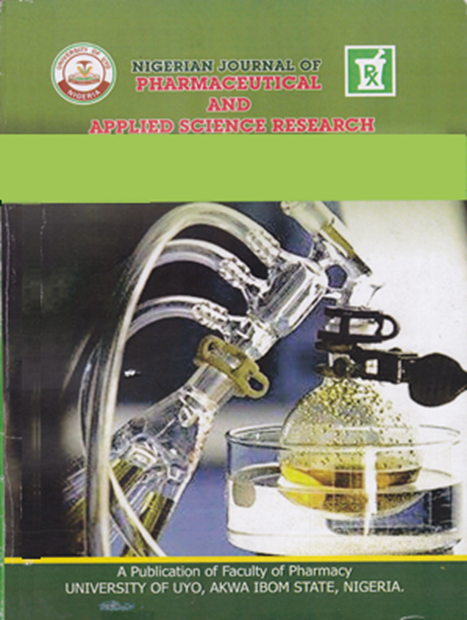Chemical analysis of Hemidactylus frenatus (Gekkonidae) Schlegel, 1836 tail: An emerging substance of abuse in Nigeria
Main Article Content
Abstract
Background: The campaign against substance abuse requires empirical validation. This study investigates the psychoactive and toxic chemical content of Hemidactylus frenatus tail, a substance increasingly abused by Nigerian youth.
Methods: H. frenatus tail were collected by cutting off the tails of live H. frenatus caught in buildings at the Federal University, Otuoke, Bayelsa state. Collected samples were sun dried for ten days, pulverized and then processed for analysis. The chemical constituents of the concentrated extracts of H. frenatus tail were determined with a Gas Chromatography-Mass Spectrometry (GC-MS) machine.
Results: The result showed twenty-four compounds along with their nomenclature, chemical formula, structure, molecular weight, retention time and peak area, amongst which four are psychoactive and six are toxic. The most abundant constituent by peak area was shown to be 9,12-Octadecadienoic acid (10.56%). The constituent with the highest retention time (21.500mins) is shown to be cyclopentanetridecanoic acid and it was also the constituent with the highest molecular weight (356Da). Identified psychoactive compounds among the discovered constituents in H. frenatus tail were 9-octadecenamide, indolizine, 2-furan-methanamine and 2- piperidinone while the toxic chemicals identified among the constituents of H. frenatus tail includes indolizine, propanenitrile, 9-octadecenamide, oleic acid, 2-piperidinone and 2-furanmethenamine.
Conclusion: These findings highlight significant health risks and underscore the need for targeted public interventions to curb this trend.
Downloads
Article Details

This work is licensed under a Creative Commons Attribution-NonCommercial-NoDerivatives 4.0 International License.
References
. Glynn, T.J. (2018). From family to peer: transitions of influence among drug- using youth. Journal of youth and adolescence,10:363-383
. Siegel, A. & Ronald, K. (2015). Intoxication: the universal Drive for Minding- Altering Substances. Parkstreet press, 60:99-108
. Lix, O. & Pearce, R.A. (2015). Effects of halothane on GABA receptor kinetic: evidence for slowed agonist unbinding. journal, 20(3): 899-907
. Garg, M., Sidhu, B.S. & Raj, R. (2014). Addiction to lizard. Indian journal psychiatry 56(2): 244-249
. Aich, T., Saha, I., Ram, D., Ranjan, S. & Subedi, S. (2015). A comparative study on 136 opioid abusers in India and Nepal. Journal of Psychiatrists’ Association of Nepal (2):11–17.
. Varghese, S.T., Balhara, Y. & Mondal, A. (2006). Unconventional substances of abuse: scorpions and lizards. Journal Postgraduate Medicine, 52:325-6
. Sarkhel, S., Praharaj, S. K. & Sinha, V. K. (2011). Does lizard tail lacing heighten cannabis addiction? The American Journal on Addictions, 20:181–181
. Malhatra, C. (2017). Drug abuse among juveniles in conflict with law, Journal of Pediatrics 74(3): 352-356
. Case, T.J., Bolger, D.T. & Petren, K. (2006). Invasions and competitive displacement among house geckos in the tropical pacific. Ecology, 75(2): 464-477
. Cameron, S.F., Wynn, M.L. & Wilson, R.S. (2013). Sex-specific trade-offs and compensatory mechanisms: bite force and sprint speed pose conflicting demands on the design of geckos (Hemidactylus frenatus). The Journal of Experimental Biology, 216 (0) 3781-3789
. Ikimi, C.G. & Addy, P.S. (2024). Effects of a mixture of methylated spirit and carbonated cola drink (a novel substance abused by Nigerian youths) on the lipid profile of Wistar rats. International journal of health and pharmaceutical research (international institute of research and academic development), Vol. 9 (3): 83 – 92.
. Agoro, E.S., Ikimi, C.G. and Edidiong, T. (2021). The use of vitreous renal chemistries in the discrimination of postmortem fresh water drowning. Toxicology research and application, Vol. 5: 1-6.
. Ezenwa-Ohaeto, N. (2013). Sociolinguistic import of name-clipping among Omambala cultural zone in Anambra State. Creative Artist: A Journal of Theatre and Media Studies 7(2): 111 – 128.
. Sparkman, O.D., Penton, Z.E. & Kitson, F.G. (2011). Gas chromatography and mass spectrometry: a practical guide, second edition, Academic press publishers,15-20.
. Sanggaard, K.W., Danielsen, C.C., Wogensen, L., Vinding, M.S., Rydtoft, L.M., Mortensen, M.B., Karring, H., Nielsen, N.C., Wang, T., Thogersen, I.B., & Enghild, J.J. (2012). Unique structural features facilitate lizard tail autotomy. PLoS ONE 7(12): e51803
. Juang, S.S., Chang, M., Wang, L.F. & Han, J.L. (2005). Environmentally benign one-pot synthesis and antimicrobial activity of 1-methyl-2; 6-diary/piperidine-4-ones. Tetrahedron, 61:1693-1697
. Singh, G.S. & Mmatli, E.E. (2011). Recent progress in synthesis and bioactivity studies of indolizines. European journal medicinal chemistry, 46: 5237-5257
. Synder, R. (2005). Ethel Browning’s toxicity and metabolism of industrial solvent. Elsevier publishers, 2: 356-360
. Pala, V., Krogh, V., Multi, P., Chajes, V., Riboli, E., Micheli, A., Sieri, S., Saadation, M. & Bernno, F. (2002). Erythrocyte membrane fatty acids and subsequent breast cancer; prospective Italian study. Journal of the national cancer institute, 93(14): 1088-1090
. Mckinney, M. & Cravatt, B.F (2005). Structure and function of fatty acid Amide Hydrolase. Annual Review of Biochemistry. 74(1): 411-432
. Raphael, M., Ester, F., Lumir, H., Tzviel, S., Tiziana, B., Vincenzo, M., Micheal, B. & Zvi, V. (1997). Anandamide may mediate sleep induction”. Nature, 389 (6646): 25-26
. Trincado, M., Kuhlein, K. & Grutzmacher, H. (2011). Metal-Ligand Cooperation in the Catalytic Dehydrogenative Coupling (DHC) of Polyalcohols to Carboxylic Acid Derivatives, Chem. Eur. J., 17(42):11905-11913
. Pingen, D. & Vogt, D. (2014). “Amino-Alcohol Cyclization: Selective Synthesis of Lactams and Cyclic Amines from Amino-Alcohols”, Catal. Sci. Technol., 4:47-52
. Al-Bahadily, D.C.H., Shari, H.F., Najim, M.A.A. & Al-Salman, H.N.K. (2019). Clinical pathogenic isolated antimicrobial activity of the compound 2-Piperidinone, N-[4-Bromo-n-butyl] extracted from pomegranate peels, Asian Journal of Pharmaceutics, 13(1): 46-53
. Kuroda, K., Ishii, Y., Takasu, S., Matsushita, K., Kijima, A., Nohmi, T. & Umemura, T. (2022). Toxicity, genotoxicity, and carcinogenicity of 2-methylfuran in a 90-day comprehensive toxicity study in gpt delta rats. Food Chem Toxicol.168:113365
. Tian, M., Peng, Y. & Zheng, J. (2022). Metabolic Activation and Hepatotoxicity of Furan-Containing Compounds. Drug Metab Dispos; 50(5):655-670
. Ikimi, C.G., Adias, T.C. and Agoro, E.S. (2024). Effects of a mixture of methylated spirit and carbonated cola drink (a novel substance abused by Nigerian youths) on kidney function and haematological parameters in Wistar rats. Otuoke Journal of Medical Laboratory Science, Vol. 1 (1): 119 – 128.


